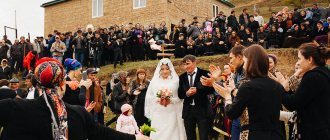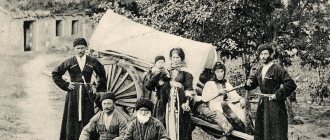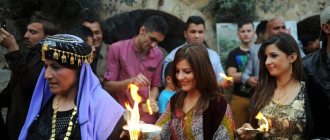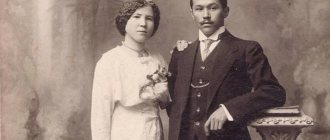In Kazakhstan, the choice of the bride and groom is made by their parents. A collusion is a parental agreement to engage their children. If families are friends and expect to become related in the future, and the families do not yet have children,
then this conspiracy is called “bel kuda”, and in the case when the children are still small, but they are being “wooed” - “besik kuda”.
Kazakh wedding: viewing
Nowadays, the ancient tradition of the Kazakhs to find a bride during the bride ceremony, which is called “kyz koru”, has been practically forgotten, as well as the custom of marrying at the will of the parents. Young people now choose their own couples and marry for love. However, there were times when families with small children agreed to marry them without asking the opinion of the future bride and groom. In some cases, such agreements were concluded even before the birth of heirs, for example, if families wanted to become related.
Remembering how a Kazakh wedding was held in the past, one cannot fail to mention the bride's party. Not every resident of Kazakhstan had the right to choose a bride during the bride ceremony (“kyz koru”); it was mainly given to skilled horsemen who were able to prove their skills, as well as the offspring of wealthy or famous parents. A young man who wanted to get married, together with his friends, went to an aul where attractive girls who had reached the age of brides lived. As a rule, the potential groom and his entourage were received with honor.
During the show, girls of marriageable age competed with each other in various forms of art. They also assessed possible suitors without hesitating to express their opinions. Often there were song competitions between young ladies and gentlemen - “aitys”. If a spark ran between a boy and a girl, then it was the turn of the matchmakers, who went to the bride’s family.
Arrival of the groom to pick up the bride (custom of a Kazakh wedding)
The next stage of the Kazakh wedding is the arrival of the groom to pick up the bride.
Great importance was attached to the groom's clothing; it had to be more elegant than that of other zhigits, so that he could be immediately recognized. The groom's headdress (borik) was decorated with eagle owl feathers (uka), and a red chapan was draped over his shoulders. The groom had to complete a number of tasks; if he failed, he had to pay a fine. According to the customs of the Kazakh wedding, the bride was dressed in her wedding dress in her father's house. The Saukele Kigizu tradition occupied a special place. This is a particularly solemn ceremony for the bride, when a wedding headdress was placed on the bride’s head - a saukele with a special zhelek cover, in which she was supposed to arrive at the groom’s village. According to folklore, another indispensable attribute of the bride’s wedding clothes were gloves. Saukele is not only the most expensive part of the bride’s decoration, it also served as a symbol of the beginning of a new life, a memory of the girl’s former carefree life. The saukele was worn by a respected woman on the bride, for which she received an expensive gift from the groom.
At saukele kigizu they invited matchmakers and matchmakers and showered them with shashu (candies, sweets, coins). They gave bata (blessing). The ransom (baygazy) for a saukele could be very significant, because in a saukele the bride looked especially elegant, luxurious and unique. For the look they gave an appropriate korimdik (gift).
On the day of the bride’s departure, the matchmakers were shown the dowry - zhasau, the wedding yurt was dismantled, the festive caravan was prepared for departure and gifts were presented to the matchmakers, the bride and groom. Zhasau (bride's dowry) often exceeded the value of kalyn mal. Beautiful jewelry, carpets, tekemets (patterned felt mats), saukeles, expensive clothes, things, and dishes were necessarily included in zhasau. wealthy parents prepared an ak otau (white yurt) for their daughter.
The groom, coming for the bride, according to the tradition of the Kazakh wedding, brought toy mala, that is, livestock for the wedding: horses, cows or rams. Cattle were slaughtered for the feast at this wedding. They also brought expensive fabrics, things, fruits, sugar, tea. The authority of the son-in-law in the future largely depended on the quantity and quality of that mala. If the gifts did not correspond to the wealth and position of the groom, then the wives of the older brothers could make caustic reproaches about this.
At the wedding toy, various games were held: baiga (horse racing), kures (wrestling), sayys (combat of riders), and the fight of riders for the carcass of a kid. The wedding ceremony was accompanied by the singing of choral songs (zhar-zhar), which expressed wishes for a happy life for the newlyweds. On the eve of departure, the bride and her older brother’s wife or friend went around to all the relatives and said goodbye to them. The relatives showed her appropriate honors and presented her with gifts as a keepsake. While visiting the relatives, the bride sang the traditional song “Sunsu”. In our time, this custom has begun to be forgotten.
Matchmaking
Matchmaking is an obligatory part of such an event as a Kazakh wedding; in the Kazakh language this ceremony is called “kuda tusu”. The role of matchmaker is traditionally assigned to the father and other close relatives of the groom. The bride's family is warned about their visit in advance and is obliged to provide generous refreshments (of course, if they like the candidate). However, matchmakers are forced to pay for entry into the girl’s house, since the female half of the family traditionally holds out a lasso in front of the door, which is removed only after the guests present gifts to the owners: pieces of expensive fabric, money.
The atmosphere at festive dinners is warm and friendly, during the meal various topics are discussed that are not directly related to the future wedding. Only when dinner is nearing completion are the matchmakers allowed to move on to the purpose of their visit. The conditions for the marriage ceremony are discussed, and the size of the bride price is established. The right to speak is given to all senior members of both families. Matchmaking, which traditionally precedes a Kazakh wedding, is also not complete without the ritual of sprinkling “shashu”. The groom's delegates are showered with sweets, cookies, small coins by the bride's relatives, and the matchmakers may also be forced to undergo various tests and take part in a fun performance.
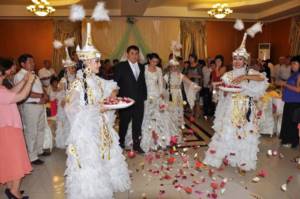
Representatives of the groom who come to woo the girl are required to have a “korzhun” with them. This is a bag decorated with bright ribbons, beads, and coins. Inside it are gifts: dried fruits, sweets, pieces of fabric, and so on. Before the matchmakers leave, gifts are given to them, and the most valuable gift goes to the groom's father.
Kudalyk
Matchmaking after a big wedding is done by the groom’s side in order to properly meet the matchmakers. There is even a saying - “Kudalyktyn belgisi - barys kelis”, “The sign of matchmaking is mutual visits.” But now, the groom’s side often conducts kudalyk on the day of the party, and kudalyk is performed for the bride’s relatives during their arrival at the big wedding. The reason for this action is lack of time, since there are a huge number of people at Kazakh weddings.
It doesn’t matter when Kudalyk takes place, because its main purpose is the exchange of gifts. The Kazakhs say: “Kudalyk belgisi - kiit, konys belgisi - beit” “The sign of matchmaking is gifts, and the sign of housewarming is graves,” and of course, a warm and friendly atmosphere. We also say that any Kazakh: “Respects and honors the matchmaker like a god.” In the main dish, beshbarmak, a lamb's head is served to the matchmaker. Also, during matchmaking, Kazakhs want the matchmaker to become like a friend, and the matchmaker to be like their closest friend, sister.
The exchange of gifts is called “Kiit”. In this ritual, gifts are made from clothes. Matchmakers exchange lists in advance indicating the clothing sizes of each member of the relatives for whom they will buy gifts. They buy various kinds of things: outerwear, for example coats, chapans, suits, shirts, blouses, etc. Today, this tradition is carried out differently in different regions of Kazakhstan. Some matchmakers say to each other: “Perhaps we won’t dress each other.” “Sir bezdi, bez sizd kiindirmey ak koyayyk.” However, in any case, both sides of the matchmakers are not left without gifts.
Bride show
The future newlywed goes to the matchmakers only after they have become acquainted with all her relatives and have agreed with them on the wedding and bride price. Before the bride leaves, the groom's representatives must present her family with a fee for the bride, which is called "korimdik" in the Kazakh language. Only after this the girl is shown to future relatives.
This is followed by a ceremony that officially assigns the girl the status of a bride. Matchmakers put earrings on her; as a rule, this honorable duty is assigned to the groom's mother. Matchmakers should also give gifts to other family members, mainly gold jewelry: necklaces, brooches, rings.
Kalym
Bride price is something without which in the old days a Kazakh wedding could not take place. Traditions tell the candidate for the girl's hand in marriage to present 47 head of cattle to her parents. Nowadays this rule is rarely observed; it is enough to put 47 small items in the gift bag that the matchmakers give to the bride’s family. The number of heads of cattle demanded for a bride in the past also depended on the wealth of the families intending to become related. For the daughter of a large bai they often paid up to 1000, while the poor were content with 5-6 heads as a bride price.
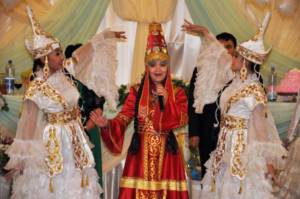
Today, such a tradition as the financial assistance provided to newlyweds by parents has been preserved. Custom orders the bride's relatives to provide her with a dowry, including carpets, bedding, dishes, and so on. The groom's relatives must allocate money to the young family to purchase furniture.
Obviously, not every engagement ends in marriage. If the groom, after the visit of the matchmakers and the payment of the bride price, suddenly decides to get married, without having the grounds provided for by custom, he cannot count on the return of the bride price. Moreover, the family of the deceived girl has the right to force the flighty young man to pay a fine, the amount of which is negotiated separately. A different situation arises if the contract is not respected by the bride or her relatives. In this case, the girl’s family must not only fully return the ransom they paid, but also compensate for the violation of the contract by paying a fine.
Uryn kelu (kynamende) (Kazakh wedding custom)
After the wedding agreement, the groom, led by a knowledgeable person, sent a gift of oli tiri to the matchmakers as a sign of respect and gratitude not only to the living.
After this gift, the groom can secretly visit the bride (uryn kelu or kynamende). After matchmaking and paying the bride price, the groom went to visit his bride for the first time. This ceremonial visit was called kynamende or uryn kelu. Before the kynamende, the groom, according to the customs of the Kazakh wedding, did not have the right to visit the house or village of the betrothed girl. The future groom, allegedly secretly, at dusk, with his retinue solemnly arrived at the bride's village. To visit the bride, the groom's side followed a number of required customs. For example, daughters-in-law, citing shortness of breath when walking quickly, brought entikpe, and when meeting the brother-in-law or younger sister of the bride, baldiz korimdik. Regarding the girl, the rite of kynamende or uryn kelu is called kyz kashar.
The day after the “kynamende” there was a general fun with songs and dances, called “uryn toy”. For young people, this day is a joyful, cheerful one, where young zhenges were animatedly scurrying about. They took kol ustatar, shash sipatar, kyz kushaktar, arka zhatar and other gifts from the groom. It was the day two lovers met. The girl gave the zhigit her scarf as a sign of virginity and gave gifts to his brothers and sisters.
If after the wedding the matchmakers’ agreement was violated, then if the groom refused to marry the girl, then the bride price he paid was not returned and he additionally paid a fine, but if the agreement was violated by the bride, then the bride price was returned in full and a fine was also paid.
Bride's outfit
All over the world, girls getting married are sensitive to the choice of outfit, and brides who are about to have a Kazakh wedding are no exception. According to tradition, the bride's dress should be red, but nowadays Kazakh women can choose a white robe. Over the dress, which usually has wide and long sleeves, a velvet vest embroidered with ornaments is worn; it can be any color.
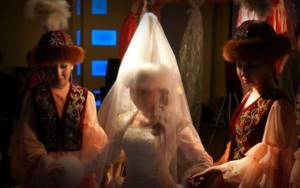
The bride’s headdress, called “saukele,” is an element without which it is difficult to imagine such an event as a Kazakh wedding. A photo of a girl wearing a traditional headdress can be seen above. “Saukele” looks like a work of art; custom orders it to be decorated with pearls and rubies, and made of expensive fabrics (velor, velvet). Beads, fringe, and silver coins are also used as decorative elements. The upper part of the headdress is decorated with a bun made from eagle owl feathers, the edges are trimmed with fur (fox, sable, mink). The wealth of “saukele” allows you to demonstrate the financial capabilities of the family.
“Saukele” looks so luxurious that friends and relatives invited to the wedding are ready to give small gifts for the right to admire the bride dressed in this headdress.
Groom's outfit
Not only the bride is obliged to carefully prepare for such an event as a Kazakh wedding. According to custom, the groom's costume should surpass, in terms of wealth, the vestments of any guest. A man getting married must stand out from the crowd, which is helped by a special headdress, the upper part of which is decorated with eagle owl feathers. Also, traditions tell the groom to appear at the wedding ceremony in high-heeled boots, throwing a red caftan called “chapan” over his shoulders.
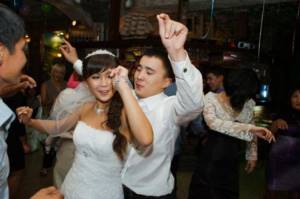
Nowadays, Kazakhs practically no longer dress so magnificently; no exception is made even for such an event as a Kazakh wedding. Modern customs favorably allow young people to wear a snow-white shirt and trouser suit. It is desirable that the suit fits perfectly, so it is sewn to order, the color does not play a special role. However, many men still do not forget about the national headdress, which emphasizes the splendor of the ceremony.
The groom who is about to have a Kazakh wedding should not only worry about his outfit. Customs tell him to bring with him “that mala,” the name given to the cattle for the wedding, which will be slaughtered for the feast. The quantity depends on the wealth of the family; it can be several rams, horses or cows. They also take other gifts with them, for example, expensive fabrics, fruits, tea. It is curious that the attitude of the bride's family towards the son-in-law depends on the amount that he can allocate for offerings. If the girl's relatives remain dissatisfied with the wealth of gifts, customs allow them to express their dissatisfaction. As a rule, this function is assumed by the wives of the bride's brothers.
Wedding suits for grooms and dresses for Kazakh brides
The main color of wedding fabric for the Kazakh bride’s dress was red. However, for a modern Kazakh celebration, the bride can also wear a white wedding dress.
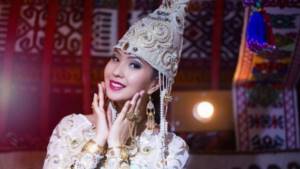
The main element in the bride's image is the saukele - a high headdress, which is made of expensive and high-quality fabrics, decorated with precious jewelry, beads, coins, and fur. This headdress is mandatory according to the wedding tradition that has developed among the Kazakhs since ancient times.
The groom's suit should be the richest and look more elegant than other horsemen, so that it is clear from the crowd who is getting married. The groom wears a red chapan on his shoulders, and his headdress is decorated with eagle owl feathers. At a modern Kazakh wedding, the groom can wear a regular formal suit.
The portal www.svadbagolik.ru told you about the Kazakh wedding with its unique traditions and customs. If you are interested in learning about celebrations in other countries, then on the site you can find a lot of interesting things: both about the features of a wedding in Azerbaijan and about the unique features of a celebration in India.
Choosing a wedding day
Even when choosing a day for a wedding ceremony, Kazakhs take into account the traditions that developed many centuries ago. Most often, holidays are held in the last days of the summer season. At this time, religious fasting ends, and fruits and vegetables are in abundance, so this is the best time for such an event as a Kazakh wedding. Traditions and history show that Kazakhs can get married in the fall. In spring and winter, weddings are held less frequently.
Modern brides and grooms continue to choose the full moon period for their wedding ceremony. The reason for this decision is the bright nights, ideal for holding night games and competitions, which have been a mandatory element of the holiday for many years.
It is not always possible to guess the weather, but it also plays an important role when choosing a wedding date. It is believed that if a husband and wife get married on a cloudless, sunny day, they will not know sadness or quarrel with each other. Whereas bad weather is regarded as a bad omen, which, however, many Kazakhs do not pay attention to.
Seeing off the bride
Seeing off a girl (“kyz uzatu”) is a beautiful ceremony with which a Kazakh wedding has begun from time immemorial. Traditions tell the bride's family to laugh and shed tears on this day. Joy should be caused by the fact that the daughter getting married has grown up to be beautiful and smart. The source of sadness is the need to part with the girl, who will henceforth belong to another family.
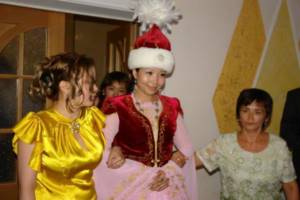
Matchmakers take the bride out of the house very early, often her departure coincides with sunrise. The tradition did not arise by chance, because sunrise throughout the world is associated with the beginning of a new life. The family will not let their daughter leave home without the traditional farewell song, which is called “Costasu Heat.” The number of matchmakers is also important; it should be odd. Usually 5-7 matchmakers come for a girl, but more people are possible. The procession is led by the chief matchmaker, who calls himself “bas kuda.” The bride will have to treat this person with respect throughout her life.
"Bride's Dowry"
After seeing off the bride on one of the appointed days, or the next day, the daughters-in-law (zhengeler) of the daughter-in-law arrive with a dowry. For example, mothers used to collect a dowry for their daughters from birth: bed linen, dishes, kitchen towels, etc. In the modern century, nothing has changed, but larger material things have been included: bedroom furniture, refrigerator, TV, in a word, all household appliances, as well as clothes for the bride. It should be noted that everything depends on finances, but the Kazakhs emphasize the great importance of kyz uzatu. During the analysis of the dowry, all his relatives, including neighbors, are present in the groom’s house. In a good atmosphere, they all evaluate what kind of dowry they brought for their new daughter-in-law.
wedding ceremony
“Neke Kiyar” is a ritual without which a Kazakh wedding cannot take place. Traditions dictate that a mullah be invited to perform the wedding ceremony. A bowl filled with water and covered with a cloth is placed in front of this person. Sometimes sugar and salt are added to the water; according to beliefs, this brings happiness to the newlyweds and protects them from adultery. Relatives and friends invited to the ceremony gather around the mullah. He says prayers, after which the bride and groom, in the presence of witnesses, confirm their consent to the marriage.
Sharia law states that a Kazakh wedding cannot take place if a girl is pregnant. Customs recommend postponing the ceremony until the child is born. Nowadays, this rule is no longer so strictly observed, especially when it comes to the first months of pregnancy, when it can still be hidden.
How are Uzatu screenings conducted?
In Kazakhstan, the first stage of the wedding ceremony is kyz uzatu, or bridesmaid. Relatives and friends from the husband's side (necessarily in odd numbers) came on the appointed day to look at the bride.
The most important matchmaker among them was necessarily appointed. The bride's relatives were obliged to warmly welcome the guests, feed them and treat them to tea.
Please note that the groom often did not come to the bridegroom at all. Now this ritual is practically not used by anyone. Only extremely religious families adhere to it.
At dawn, the matchmakers put the bride in a cart and drove her in this way to the groom’s house, even if he was in a neighboring village.
The girl said goodbye to her loved ones and sang a farewell song. It is noteworthy that, while sitting in the cart, the young lady was forbidden to turn and look at her father’s house . She just had to be sure to look forward.
Farewell ceremony
Having entered into marriage, a girl must solemnly say goodbye to her father’s house; the ceremony is called “koshtasu”. “Koshtasu” is an important part of such an event as a Kazakh wedding, the customs and traditions of which are still not forgotten by the residents of Kazakhstan. The newlywed must say heartfelt words of farewell to all family members without exception: mother, father, brothers, sisters, as well as other relatives living in the house.
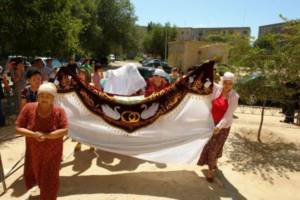
Also, the girl certainly sings a farewell song, with the help of which she expresses her regrets. The newlywed should express pity that she was born not a boy, but a girl, which is why she has to leave her home, while her brothers can stay with their parents. She also promises to visit her family soon and wishes the relatives good health and happiness.
We must not forget about another interesting custom that is associated with such a ceremony as the Kazakh wedding, the features of which often surprise representatives of other nationalities. The newlywed should not appear in her parents' house for a whole year after the wedding. This is done to make the process of getting used to the girl’s new home as simple as possible. However, this does not mean that the bride will not be able to see her parents and other relatives for a whole year. The main thing is that the meeting does not take place in the father’s house, therefore, the rule will not be considered violated.
Modern traditions
After the matchmaking takes place, the groom and his relatives are allowed to look at the bride. This can only be done after the ransom. If the family does not want to, then they may not see their daughter-in-law at all before the wedding.
As a rule, everyone pays ransoms in order to look at their future relative. At this time, the groom's mother puts one earring on her daughter-in-law. This means that the girl is about to become someone's wife. It is forbidden to remove jewelry before the wedding.
After everyone has agreed on where and how the celebration itself will take place. The bride's father sets the size of the bride price.
The groom's task is to collect money and ransom his chosen one. The size of the bride price is discussed individually. It can be expressed both in monetary form and in animals, carpets, and dishes.
Currently, the custom has changed a little, since not everyone keeps livestock, so there is no need for it. Often, the bride's relatives only ask to furnish the future home of the newlyweds , purchasing all the necessary furniture and equipment for it.
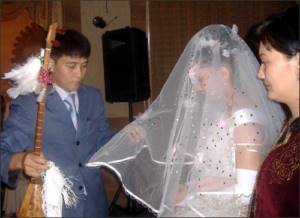
Kazakh bride.
The wedding ceremony takes place in the presence of a mullah. He pours two bowls of water: sweet and salty. After each prayer, the young people must take one sip from the cup. This will help them protect themselves from betrayal and bring prosperity and happiness into their home.
Witnesses are present at the wedding. Their role is to serve bowls and bowls to the young people every time. A man and a woman must tell everyone about their intentions to get married.
As a rule, the ceremony itself takes place at the end of summer . This choice is due to the fact that most fruits and vegetables are ripe.
They are especially sensitive to weddings with pregnant girls. They are prohibited from marrying for religious reasons before the birth of the child. Now these customs are neglected and people try to get married as quickly as possible, especially if the girl is in the first months of pregnancy.
The rituals do not end after the wedding ceremony. Even today, a custom called a farewell song has been preserved. At the end of the celebration, the girl says words of gratitude to her parents and sings a musical composition about her father’s house.
She grieves that she cannot continue to live with her mother and father, and envies her brothers and sisters who continue to live there.
It is also surprising that according to Kazakh canons, a married girl does not have the right to visit her parents exactly one year after the wedding.
At the groom's house
What happens after the Kazakh wedding ends, how does the newlywed get acquainted with the new home? The arrival of the girl is also arranged with all solemnity, the ceremony is called “kelin tusiru”. According to tradition, the entire village must take part in welcoming the bride. Interestingly, it is not customary for a newlywed to be dropped off at the doorstep of the house in which she and her husband are to live. She is dropped off quite far from the village, and her future neighbors come out to meet the girl. They escort the bride into the house without allowing her to reveal her face.
This is not the end of the traditions that govern a Kazakh wedding, the peculiarities of which may surprise foreigners. The newlywed must definitely step over the threshold with her right foot, otherwise family life will not work out from the very beginning. In the house, she and the accompanying women are showered with sweets and congratulations are offered. A sumptuous feast follows, to which all acquaintances are invited. The meal is accompanied by fun contests and competitions. The bride is not shown to the guests right away; she spends some time in the house behind a special screen.
Face Revealing Ritual
The ceremonial entrance of the bride is the next stage of such a holiday as a Kazakh wedding, the traditions and stories of which go back centuries. The newlywed, hiding her face under the veil, is brought out to the guests at the height of the feast, by which time all the people invited to the celebration have already gathered. The ceremony of revealing the girl’s face is called “betashar” and is always accompanied by traditional songs. Next, the newlywed officially meets her husband’s relatives, respectfully listens to their wishes for health and happiness, and friendly advice. After this, the newly made husband and wife finally turn into a separate unit of society.
There were times when the bride did not have the right to attend the feast that invariably ends a Kazakh wedding. Modern customs and traditions no longer force the newlywed to wait for her wedding night in a separate room, remaining under the watchful eye of her husband’s mother. Brides these days mostly have fun on the occasion with everyone else.
Interesting Facts
The above describes how a Kazakh wedding is held; photos taken during the festive ceremonies can also be seen in the article. However, not all interesting facts regarding such events are listed. For example, few people know that once upon a time girls became brides at the age of 13-14, and boys were considered ripe for marriage at 14-15. Starting a family at such a young age was considered useful; from a moral point of view, young people did not have time to commit indecent acts.
An ancient custom did not allow a guy and a girl who belonged to the same family to become husband and wife. It is not surprising that many Cossacks today know their ancestry very well and are familiar with relatives up to the seventh generation. The age of the people wishing to get married was also taken into account. It was unacceptable for the bride to be more than 8 years older than the groom. A man could be 25 years older than his future wife. Now such restrictions are observed less strictly than in past times, however, they have not yet been completely forgotten.
Another interesting custom concerns toasts, without which a Kazakh wedding is not complete. The right to make toasts is granted only to older relatives; speeches by younger relatives at the wedding feast are considered an insult.
These are the most interesting information about such a grandiose event as a Kazakh wedding. Customs, traditions, photos - the article contains all the information regarding this festive event.
Kazakh wedding. Traditions and customs of the Kazakh people
The parents were always worried about their son's marriage. The future bride was looked for before the son reached adulthood. We were looking for a suitable family of good, noble, respected people. Kyz aittyru
The parents were always worried about their son's marriage. The future bride was looked for before the son reached adulthood. We were looking for a suitable family of good, noble, respected people. If they found out that there were people in the girl’s family who were sick from bad heredity, then she was not matched. They specifically went to people who were respectable, in their opinion, to talk about the future of their children, expressing a desire to become matchmakers.
There are different types of “kyz aittyru”. If the children (boy or girl) are small, or have not even been born yet, and the families agree to become matchmakers in the future, it means they know each other very well and have been friends for a long time. Before the babies are born, if, of course, later some have a boy and others have a girl, they agree to become matchmakers (atastyru). The above-mentioned matchmaking is called “bel kuda” (before the birth of children). Well, if they woo children from the cradle - “besik kuda” (besik - cradle). Sometimes a man who has married his son to a matchmaker's daughter himself marries his daughter to his matchmaker's son; they are called “karsy kuda” - “mutual matchmaker”. People who continued their matchmaking, that is, who became matchmakers twice, are called “suyek zhangyrtu.” The marriage of adult children takes place after “kuda tusu” (matchmaking).
Kazakh family relations were taken into account mainly up to the seventh generation. This is evidenced by an ancient custom that prohibits marriages between men and women of their own kind. According to the rules of marriage, a woman should not be more than 8 years older than a man, and a man should not be more than 25 years older than a woman. Permission is not given for an unequal marriage.
“Kyz aittyru” serves as a kind of basis for a strong and exemplary family.
Kyz koru
Bride. “Kyz koru” was sometimes called “kyz tandau”. According to custom, children of famous parents or simply skilled zhigits organized shows of girls for marriage. Having heard that in a distant village there was a good, beautiful girl of marriageable age, the zhigits and their friends went to choose their betrothed. The Kazakh folk proverb “kyzdy kim kormeidi, kymyzdy kim ishpeidi” - “Just as there is no prohibition on drinking kumiss, so on looking at girls” opens all roads for zhigits.
Such zhigits were not prohibited from viewing girls. They tried to greet them with honor. Proud, freedom-loving girls of the aul expressed their will with the words “kyz koretin zhigitti biz korelik” - “we want to organize such shows” and began competitions in various types of art. They looked at the zhigits appraisingly and expressed their opinions openly. At such meetings, aitys often started between girls and zhigits. The girl and the zhigit liked each other, explained their feelings, and the zhigit sent matchmakers. The choice was left to the lovers.
But young people were not always allowed to choose their mate. Only the children of influential people or famous zhigits could do this.
Shege Shapan
“Shege Shapan” is a special gift. After mutual agreement, the matchmakers present each other with gifts as a sign of respect. From the zhigit side, it is a “kargybau” (literally kargy - bridle, bau - reins), in fact a horse or pacer. And the girl’s father throws a festive shapan on the shoulders of the groom’s trusted messenger (zhaushy) - “shege shapan” (shege nail). Seeing a new chapan at the zhaushy, those who greet him shower him with “shashu” - candies, sweets and money.
Where to hang out
Matchmaking. An ancient, unforgotten, obligatory tradition of the Kazakh people.
The young man's father and close relatives go (sometimes without the young man's father) to woo the girl. The matchmaking process was quite difficult and interesting. The arrival of matchmakers is called “kuda tusser”.
The girl's father, notified in advance of the matchmakers' arrival, invites his family and friends. The matchmakers are solemnly received. After the father gives the go-ahead, both parties present each other with gifts according to tradition: kuda attanar, kuda tartu, at bailar, kuyryk-bauyr, etc. the most important representative of the matchmakers is called “bas kuda” (bass is the main one), the fathers of the bride and groom are called bauyzdau kuda, i.e. the closest ones.
Bas kuda (the main matchmaker) traditionally takes care of the girl even after the wedding. She will call him “agaeke” (uncle), and he will be obliged to always take care of her. As a daughter-in-law, she reveres him all her life.
“Kuda tusu” is the most highly revered, significant one, carrying a special national flavor.
Bata ayak
The final agreement between the matchmakers. Having received consent to become a matchmaker, the groom's father goes to the girl's village and finally negotiates the date of the wedding, the amount of kalym, kade-zhora (gift). This part of matchmaking is called “bata ayak”, and in some places – “sirga tagar” or “batalasu”. There are two types of baht.
Kesimdi bata - the final decision - they specifically set the date for the wedding, the amount of expenses, and the number of livestock.
Kesimsiz bata - the exact number of livestock and costs are not discussed, but are determined later, taking into account circumstances and time.
Valuable gifts were given between wealthy, noble people during matchmaking: “bak zhaksy” - a camel with a baby camel, a mare with a foal, a valuable thing or an ingot of gold or silver; “orta zhaksy” - the best camel or horse, “ayak zhaksy” - horse, cow, ram, etc.
Where is the tartar
As noted, there are a lot of traditions and customs regarding matchmaking. During entertainment, there is sometimes an interesting custom called “kuda tartar” (lit. teasing matchmakers). It consists in the fact that village women (among them there may be young guys) play various tricks on matchmakers. When the matchmakers are enjoying the conversation after the treat, the women run in and demand “where is the tartar”, rush at the matchmakers and begin to do various tricks with them: they put them backwards on a bull and carry them around the village, or they lay them on a large carpet and, grabbing the edges, throw them up , it also happens like this: the matchmaker’s legs are tied with a lasso, the other end of the lasso is thrown over the shanyrak, and the matchmaker is lifted upside down, and at the same time tugged at; or his clothes are imperceptibly sewn to the felt, and when the matchmaker gets up, the felt stretches behind him; they drag you to pour water on them or dress you up in a woman’s dress. Matchmakers must bribe women with small gifts, but in turn they can allow themselves various liberties in relation to women. Matchmakers should not be offended. Thus, the wedding ceremony turns into a fun and amazing performance, into a kind of theater, where the ingenuity and resourcefulness of both one and the other party, who will soon, by the will of fate, will become relatives, are exposed to the audience.
Kalyn is small
Kalym . After the official part of the matchmaking, according to Kazakh custom, the groom’s side had to pay “kalyn mal”, which is paid mainly in cattle. Its size depended on the wealth and condition of the matchmakers. If among poor matchmakers the bride price was limited to 5-6 heads of cattle, then between large buys it ranged from 200-500 to a thousand horses.
In addition, cattle were taken into account for entertainment at the wedding, gifts for milk to the bride’s mother (sut aky), the deceased and the living (oli-tiri), “kade” from the groom and many other gifts according to custom. During the years of Soviet power, these traditions and customs were denigrated as best they could, saying that girls were exchanged for cattle. But the dowry (zhasau) of a girl was usually not inferior in size to the bride price.
The volume of the bride price depends on the wealth of the matchmakers. If the bride price consists of 10 heads of cattle, it is called “dongelek kalyn”, that is, “rounded bride price”, if small livestock is replaced by 1-2 horses - “balama kalyn” - “replaced bride price”. If instead of the deceased bride the groom marries a baldiz (bride's sister), he pays "27" "olky kalyn", which means the same amount of additional cattle.
The procedure for paying kalym has its own unbreakable rules. One horse is given to the grooms, which is called “kurykbau”, one ram is given to the shepherd – “kosakbau”. During the blessing, cattle are also presented - “kelin tili” (daughter-in-law’s tongue). According to legend, “Kelin Tili” is paid for the daughter’s health; if “Kelin Tili” is not done, then the future daughter-in-law may be speechless.
Baldyz kalyn
Kalym for my sister's bride. If the bride, before getting married, dies prematurely, and the bride price is paid (usually it is paid in advance), the groom can marry the sister of the deceased. If the groom arranged secret dates (uryn baru), and the deceased does not have a sister, then half of the paid kalym is returned. If he went on dates with the bride, and after her death marries her sister (baldyz), then the groom is obliged to pay for an additional bride price, called “baldyz kalyn”. If the groom did not visit the bride, then “baldyz kalyn” is not paid.
Kiim tigu
Arriving matchmakers and matchmakers should not go to bed until they have tasted the food prepared for their arrival. If one of the arrivals, unable to bear it, falls asleep, then the clothes of the fallen matchmaker are immediately sewn to a pillow, blanket, carpet, felt, etc., for which the one who fell asleep must pay a fine (ayyp). Matchmakers pass all endurance tests.
Kiit
Before the matchmakers leave, the girl’s father traditionally gives them “kiits” - gifts. The most valuable “kiit” goes to the groom’s father, even if he is not among the matchmakers. Other matchmakers receive “kiit” based on their degree of relationship. In wealthy families, “kiit” to the groom’s father is a whole herd of horses, a large number of chapans and, without fail, a riding horse; Other matchmakers were given gifts accordingly. The matchmakers who came from the bride’s side also, in turn, receive a “kiit”, but it is somewhat less than the “kiit” given to representatives of the bride’s father, which is determined by the need to pay a share of the bride price.
Nowadays, “kalyn mal” is not paid, but the custom of giving “kiit” and other matchmaking traditions have been preserved.
Kuyryk-bauyr
“Kuiryk-bauyr” is a ritual treat made from liver and fat tail fat. This ritual dish confirms the fact of matchmaking and is accepted in case of disputes as material evidence of the matchmaking taking place. It imposes certain circumstances on the parents of the parties. After this ritual it is no longer possible to retreat, otherwise the guilty party pays a “penalty” and returns the bride price received.
“Kuyryk-bauyr” is a guarantee of fidelity and inviolability of the contract.
Oli-tiri
After the wedding agreement, the groom’s side, led by a knowledgeable person, traditionally sends the “oli-tiri” gift to the matchmakers. This is a symbol of gratitude not only to the living. After this gift, the groom can secretly visit the bride (uryn kelu).
Kynamende
“Kynamedne, uryn kelu” - the groom’s visit. After matchmaking and payment of the bride price, the groom goes to visit his bride for the first time. This ceremonial visit is called “kynamende” or “uryn kelu”. In the East Kazakhstan region, “kynamende” is celebrated after it becomes obvious that the girl’s honor is not tarnished. The next day there is general fun with songs and dances. “Kynamende” is called differently in different places – “uryn kelu”, “kalyndyk oinau”.
“Kynamende” for youth and zhenge – that. The future groom, allegedly secretly, at dusk, with his retinue solemnly arrives at the bride's village. This custom is called “esik koru” (lit. esik – door, koru – look) or “uryn kelu” (meaning – secret arrival). To visit the bride, the groom's side performs a number of required customs. For example, daughters-in-law, citing shortness of breath when walking quickly, bring “entikpe”, and when meeting a brother-in-law or younger sister of the bride, “baldyz korimdik”. After the “uryn toy”, the groom and his friends are solemnly seen off and presented with gifts.
Before the “kynamende”, the groom has no right to visit the house or village of the betrothed girl. Otherwise, the girl’s brothers punished the groom for violating this tradition. Traditions and customs always require adherence to decency and established order.
Kyz kashar
“Kyz Kashar” - introducing the bride to the groom. The first visit to the bride is called “uryn kelu”. These rituals take place on the same day as the “uryn toi”. However, regarding the girl, the ritual is called “kyz kashar”. For young people, this day is a joyful, cheerful one, where young zhenges scurry about animatedly. They take “kol ustatar”, “shash sipatar”, “kyz kushaktar”, “arka zhatar” and other gifts from the groom. This is the day that two young people meet. The girl gives the horseman her scarf - a sign of virginity and gives gifts for his brothers and sisters.
If the matchmakers' agreement is violated after the "uryn", this has very serious consequences. If the groom refuses the girl without reason, then the bride price paid is not returned, and he also pays a fine. If the contract is violated by the bride, then the bride price is returned in full and a fine is also paid.
Saukele Kigizu
“Saukele kigizu” (lit. saukele – bride’s headdress, kigizu – to wear). The Kazakh people have many traditions and customs. The tradition of “saukele kigizu” occupies a special place. “Saukele” is not only the most expensive part of the bride’s decoration, it also serves as a symbol of the beginning of a new life. This is a memory of the girl’s former carefree life. “Saukele kigizu” is a particularly solemn ceremony for the bride. Matchmakers and matchmakers are invited to the ceremony. They are showered with "shashu". They give bata (blessing). “Baygazy” (ransom) for “saukele” can be significant. In “saukele” the bride looks especially elegant, luxurious, and unique. Everyone wants to see “saukele” on the bride. For a “look” they give a corresponding “korimdik” (gift). The creation of a new hearth, the bride in the saukele, games, laughter - all this is an omen of a new life.
A few words about “saukele”. “Saukele” is not only a bride’s headdress, but also a work of art. It is embroidered with rubies, pearls, corals or other precious stones that emphasize its wealth. “Saukele” is sewn from expensive velvet or velor, embroidered with small beads, trimmed with fringe, and the ornaments are made from various small gold and silver coins and figured plates. The top of the “saukele” is invariably crowned with “uky” (a fluffy bunch of eagle owl feathers). The edges are decorated with mink, mare or fox fur. The beauty of such a dress captivates the eye, adorns the bride and demonstrates the wealth of the matchmakers.
Kuieu kiimi
Kuieu kiimi - groom's clothing. The groom going to pick up the bride must dress especially smartly so that the women and girls who meet him can unmistakably identify him. According to custom, the groom's clothing differs from the clothing of the zhigits accompanying him. He attaches “uki” (eagle owl feathers) to his “borik” headdress, puts on high-heeled boots, and puts a red chapan over his shoulders. The groom pulls his “borik” over his eyes and behaves very modestly, showing respect with his entire appearance, otherwise he will have to pay a fine or be laughed at. Finding himself in this form among women, the groom patiently endures their ridicule and barbs. The groom's horse turns into an object of fun for the children - they can ride it to their heart's content. This is the tradition of the village.
Toy small
Livestock for a wedding. The groom, coming for the bride, brings “that mala,” that is, cattle for the wedding. It is being slaughtered for the feast at this wedding. Depending on their wealth, matchmakers bring several horses, cows or sheep to the “toy mala”. They also bring expensive fabrics, things, fruits, sugar, tea, etc. The son-in-law’s authority in the future may depend on the quantity and quality of “that little” gifts. If they do not correspond to the wealth and position of the groom’s family, then “kyzdyn zhengeleri” (wives of the girl’s older brothers) can express caustic reproaches and barbs about this.
Kapka salar
Gift for son-in-law. After that, when on the appointed day the groom and his retinue, having given everyone the required gifts, take the bride to his village, the bride’s father gives all the matchmakers, according to tradition, “kiit” (from the word “kiyu” - to dress). The new son-in-law is also given clothes as a gift. The gift is called “kapka salar”
Zhigit tuye
A gift for the girl's father. Among the wedding rituals, the groom presents his mother-in-law (ene) with “sut aky” for the good upbringing of the girl, and the due “zhigit tuye” to the girl’s father. This gift could be expensive clothes, a camel, a horse, horse harness, etc. then the father-in-law (ata) blesses his son-in-law.
Sut aky
Payment for mother's milk. The date for the girl’s farewell after the wedding is set jointly by the bride’s father and the groom’s matchmakers. The groom comes to this ceremony led by his senior matchmaker, as well as close, talented friends. Traditionally, there are a lot of gifts during matchmaking. Among others, the most special one that attracts attention is “sut aky” - payment for mother’s milk. Solemnly, with touching words, it is presented to the girl’s mother.
Kyz Tynasu
Kyz Tynasu – farewell visit. Before marriage, a girl, accompanied by the wife of her older brother, zhenge, goes around her relatives and friends to say goodbye. Relatives and friends honor her, give her gifts as souvenirs, and give her farewell wishes, wishing her happiness and joy. This is one of the ancient folk traditions and one of the examples of ethics education.
Seungsu
This was the name of the traditional song sung by a girl during “kyz tynasu” - visiting her relatives with dengue. The song sings about the years spent unnoticed in their home; about your beloved parents; about how she was cherished and protected; The song expressed regret that the time had come to leave her home and a request that she be visited and not forgotten. This is a beautiful, touching song. Unfortunately, in our time this custom has begun to be forgotten.
Kyz Uzatu
“Kyz Uzatu” - seeing off a girl. On this day, parents are both sad and happy. They are happy that they raised a beautiful, smart, worthy daughter, for whom there is no need to blush, they are sad because it is a pity to part with their daughter, it seems to them that she is not a child yet.
Matchmakers in the amount of 5-7 people (odd number), or even more, come for the girl. Among them are “bas kuda” (the main matchmaker), “kudalar” (matchmakers) and the groom’s friend (here as an adviser, an eyewitness). In the northern and central regions of Kazakhstan, only men go after girls. Matchmakers usually arrive in the evening. From the moment they arrive, games, songs, dances begin; Traditionally prescribed “kade” (gifts) are given. On this day, the girl’s close relatives officially invite the matchmakers to visit.
According to custom, the girl is sent along with the matchmakers early in the morning, at sunrise. After all, sunrise is a symbol of a new day, a new life. Before leaving, the girl says goodbye with a song (to the heat) to her relatives seeing her off. Young people sing “zhar-zhar”, “aushadiyar”. The matchmakers are given the customary “kuda attandyrar” (where – matchmaker, attandyrar – to send, see off).
Neke kiyar
“Neke kiyar” is a wedding ceremony. Marriage is a sacred act of fidelity and love in the life of every person. To perform the ritual, a mullah is called and a cup of water covered with a scarf is placed in front of him. Relatives and friends of the bride and groom gather. The mullah reads prayers, then, in front of witnesses, following the traditional form, asks about the consent of the young man and the girl to marry.
According to Sharia (Muslim law), if the bride is pregnant, the wedding ceremony is postponed and is carried out only after the birth of the child. This ritual is also not performed between young people who are related in one of the seven generations, because Kazakhs up to the seventh generation are considered relatives.
Heat-heat
A traditional song performed by young people at a farewell party for a girl. “Zhar-zhar” is performed in the form of “aitys” between girls and zhigits. The zhigits in the song advise the girl not to regret leaving her father - a good father-in-law will replace him. The girls answer that the father-in-law is unlikely to replace their beloved father. “Zhar-Zhar” is primarily of a ritual nature and is performed in a humorous manner.
Zhigit:
Don't be sad, beauty, life is beautiful, look. Don’t sigh or cry, we wish you all the happiness you can. Don't miss your father - you will have a father-in-law.
Girls:
Will my father-in-law really replace my father? How can I not cry, it’s hot, I’m leaving forever... etc.
Aushadiyar
“Aushadiyar” is a wedding song (zhyr). A traditional wedding song (zhyr) is sung to a specific tune and has a special educational value. “Aushadiyar” is a decoration and a particularly solemn moment of the toy. This is usually an example of art.
“Aushadiyar” is dedicated to a young couple who are crossing the threshold of a new life. “Aushadiyar” carries good advice and examples of education in national traditions. Eg:
Aushadiyar – let’s say once, the Wicked One does not make us happy. Respecting ancestors, the honor of descendants awaits. Aushadiyar - let's say two, Lovers have their own will, The beauty has such a slender figure, a long braid... Aushadiyar - four, Young people are beautiful in pairs, To be faithful to their given oath. Au-zhar Thanks to the abundance of songs, the girl’s farewell evening turned into an amazing performance. It's always sad to leave your home and cross the threshold of someone else's house. At the bride’s farewell, they expressed their acquired experience in the form of edification in the verses “au-zhar”. After all, the girl’s tears are not from grief, but from sadness at parting with her native village and loved ones.
The girls and zhigits of her village sympathize with her. After the ritual songs “zhar-zhar,” they perform “au-zhar” in the form of aitys, where they wish the young people happiness, joy, mutual understanding, and the benefits of family life. The words and motif “au-zhar” sound humorous and playful:
Would you be surrounded by a chain, au-zhar-au, If your father had not brought your mother, au-zhar-au? Do you really see this joy, oh-ho-oh? And I want to wish you great love, oh-ho-oh? Costas
“Koshtasu” - farewell to her home - was performed by the bride before the wedding procession left her village. Before crossing someone else's threshold, a girl at home says goodbye to her dear parents, dear brothers and sisters, and relatives. In her farewell song, she regrets that she was born a girl and not a boy; that she was forced to leave her home, she wishes everyone to be healthy when she comes to visit them. According to tradition, after the wedding, the newlywed will be able to return to her home only a year later. Before this, she does not have the right to visit her relatives (in order to quickly get used to the new family). After the farewell song, the zhenge calm the girl down (also with a song) and wish her happiness.
Zhasau
This is what a girl's dowry is called. The Kazakhs paid great attention to preparing the dowry. Beautiful jewelry, carpets, tekemets (patterned felt mats), “saukele” (bride’s headdress), expensive clothes, things, and dishes were necessarily included in “zhasau.” Wealthy parents specially prepared an “ak otau” (white yurt) for their daughter. Zhasau often exceeded the value of “kalyn mal”. The girl took whatever she wanted.
Kyz koshi
"Kyz Koshi" - bride's caravan. After performing the ritual “kuda attandyrar” (seeing off the matchmakers), the girl with her mother, older daughter-in-law, and younger brothers and sisters sit in a special cart. The girl is forbidden to look back. The matchmakers ride ahead, followed by a cart - “shanyrak tuye”. The caravan is closed by beautifully dressed guys - with songs and jokes. The girl is taken to the groom's village in a solemn ceremony. After the girl leaves the village, the procession is called "kyz koshi". After some distance - “kelinshek koshi” (kelinshek - bride). Residents of the villages, past which the “kelinshek koshi” passes, young people, daughters-in-law, girls stop the “kosh” and, according to custom, ask for “tuyemuryndyk” (gifts), after which they wish them a good journey and happiness. Giving gifts “tuyemuryndyk” is a reason to stop and receive good wishes.
Tuyemuryndyk
Women and young people passing through a wedding procession had the right to detain them and allowed them to travel further only after receiving a “kade” (the required gift according to custom). When the girl’s mother gives the “kada,” those who received the gift bless the procession, and it continues on its way to the groom’s village.
Shanyrak tuye
Shanyrak tuye is a cart for transporting the bride and her retinue to the groom’s village. Mother, sisters, and the bride’s wife can sit in the “shanyrak tuye”. Random fellow travelers or other people usually do not sit down, as they will be ridiculed later. Since time immemorial, during a move, a shanyrak, a symbol of a new home, was placed on the first camel.
Kelin Tusiru
“Kelin tusiru” - the arrival of the bride to the groom’s house (kelin - daughter-in-law, tusiru - here: to bring into the house). For the Kazakh people, the cherished dream, the greatest joy and the greatest one is “Kelin Tusiru”. The entire village is preparing for this celebration. The bride is not brought to the doorstep. According to tradition, together with the “zhenge” it is left at some (decent) distance from the village. Girls and young women come out to meet the bride and, without revealing their faces, are brought into the house and seated behind the “shymyldyk” (screen, canopy) with other girls. The threshold is always crossed with the right foot. Those greeting everyone showered everyone with “shashu” and congratulated them. The bride is accompanied by her mother, sisters, and zhenge. Relatives and friends come to the village, arrange a feast with treats and various entertainment (singing competitions, games, etc.). however, everyone is eager to see the future “kelin” (daughter-in-law). After all the guests have gathered, the bride in rich wedding clothes is solemnly led out. Her face is covered with a veil (shawl), and the improvising singer begins to sing “betashar”.
Betashar
Betashar - the ritual of revealing the bride's face (showing the bride to the groom's relatives and guests) is necessarily accompanied by a traditional zhyr song. The bride in her wedding dress is brought to the yurt of the groom's father, where the guests gather. On both sides of the bride, taking her by the arms, stand courteous, well-bred daughters-in-law. The “betashar” includes the bride’s acquaintance with her husband’s relatives, their good advice and wishes for the future in family life. The improvising singer, characterizing venerable relatives in verse, calls on the bride to bow to everyone; in response to this, the husband’s close relatives give “korimdik” (a gift “for looking”). “Betashar” ends with instructions, wishes, and advice.
Bie kysyramys
After the traditional “betashar”, the mother-in-law (ene) approaches the bride, kisses her daughter-in-law and expresses her best wishes; then he hands the women present a white cloth. Women divide the fabric equally among themselves and at home they tie this fabric around the “saba” - a vessel (skin) for shaking and storing kumis and shubat. The literal meaning of the ritual “Bie kysyramas” is - let the mare not remain barren and give birth. At the same time, this custom also carries a deep meaning.
Zholdyk
Zholdyk (rite). On the first wedding night, the wife of the elder brother (zhenge) prepares the bed for the newlyweds, jokingly gives advice for the first wedding night and wishes happiness to the newlyweds. This mission is entrusted to an exemplary, respected, well-mannered daughter-in-law with many children. It is very important that the newlyweds have an unforgettable night. Having fulfilled her duties, the daughter-in-law impatiently waits for the young people to wake up in order to ask them for a gift. The groom must thank his daughter-in-law in full and greet the first morning of their life together with a smile. “Zholdyk” is a special rite, so the gift for the zhenge should be valuable.
Otau koteru
Creation of a new hearth. The Kazakh people have the concept of “otau koteru”, which means marriage, creating a new family. According to custom, parents prepare the house for both their son and daughter. The dowry of a “Zhasau” girl includes a yurt – “otau”. The new home should bring happiness to the young family, so they decorated the yurt and tried to make it cozy. Relatives and friends, relatives on the mother’s side (nagashi), and neighbors took part in this. Aul residents take an active part in the interesting and obligatory ritual “otau koteru”. The Shanyrak (yurt dome) is raised by tying the bakan (pole) with white cloth. Shanyrak is assigned to be raised by a respected person. The revered women enter the otau first, pour oil into the fire of the hearth, coat the threshold and doorposts with oil. The first dastarkhan is served with a rich treat. Those entering the otau shower everyone around with “shashu” and express their wishes to the young people. Relatives and friends bring “korimdik” for the otau, give livestock and valuable gifts.
Kuttyk
Kuttyk (from the word kuttyktau - to congratulate). After the wedding and seeing off the matchmakers, adult girls from the zhigit village come to their father-in-law’s house with congratulations, special treats and asking for “kuttyk,” that is, jewelry, rings, earrings and cute household items. Sometimes people came specially from afar to congratulate us. Visitors were always presented with expensive things, clothes, and even livestock. Of course, only wealthy people could give rich gifts to congratulators. But in any case, this custom is an indicator of the generosity of the Kazakhs.
Oops corset
Acquaintance of the bride with her husband's relatives. After the wedding, the husband's relatives and neighbors take turns inviting the daughter-in-law to visit them to get to know each other and get closer, so that she can quickly adapt to the new place. The daughter-in-law does not come empty-handed to such an invitation. In this case, according to custom, “ilu” is used (from the verb “to hang”). The mother-in-law should determine the size of the gift in accordance with her position and capabilities. When meeting, the owners test the young daughter-in-law (character, demeanor) to see how well-mannered and courteous she is. All girls should remember this, since this custom still exists in our time.
Esik-ashar
The son-in-law, together with his young wife and close friends, go at the appointed time to visit his wife’s parents - father-in-law and mother-in-law. The son-in-law’s first visit to the house of his wife’s parents is called “esik ashar” (esik - door, ashar - open). On this day, the son-in-law is seen for the first time after the wedding. The son-in-law brings the gifts required by custom, observes all decorum and passes tests: he endures barbs from his daughters-in-law, however, he himself does not remain silent. For village residents who love holidays, laughter and fun, the arrival of a son-in-law is fun entertainment.
Onir salu
Along with the customs “uy corsetu”, “esik ashar” or “otka shakiru” (invitation to the light), another custom “kade” is performed in relation to the young daughter-in-law - “salu”. The ritual is performed by women of respectable age. They shower the kelin (daughter-in-law) with “shasha” and give her their gifts. Usually this is “onir” - clothing and household items.
“Onir salu” is a manifestation of care and respect for the newlyweds and a way to provide a little financial assistance.
Ilu
Ilu (lit. to hang). When a young daughter-in-law is invited to meet her husband's relatives, she traditionally gives them a carpet, jewelry or a cut of a dress as a sign of gratitude, listening to her mother-in-law's advice. The daughter-in-law bows, goes into the house and hangs the “il” she brought at the threshold. The son-in-law also leaves the “ila” in the house of his wife’s relatives.
Similar articles:
Wedding anniversaries → 10 years - pink wedding. Gifts and congratulations Wedding anniversaries → Pearl wedding scenario. Traditions. Wedding Anniversary Gifts → 15 years – glass wedding. Gifts and congratulations Wedding anniversaries → Golden wedding scenario. Gifts for a wedding anniversary Wedding anniversaries → Pearl wedding scenario. Traditions Discuss on the forum
